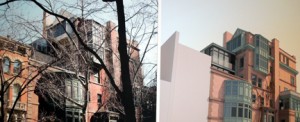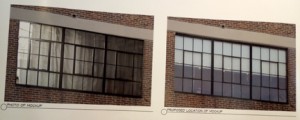Item 1
BOROUGH OF STATEN ISLAND
LP 2513
PROPOSED HARRISON STREET HISTORIC DISTRICT
HDC is especially pleased to be speaking in favor of the proposed Harrison Street Historic District, a designation which we and the community have sought for several years. If designated, Harrison Street will be Staten Island’s fourth historic district, the last one designated being St. Paul’s Avenue – Stapleton Heights Historic District in 2004. It makes logical and historical sense that Harrison Street, also known as the Stapleton “Nook”, would be next.
While Stapleton Heights boasted the mansions of Manhattan-based businessmen and top officials of local breweries, Harrison Street Stapleton was (and is) made up of the less grand, but no less special homes of the neighborhood’s merchants and professionals. Thanks to the efforts of dedicated homeowners, many of these “modest” homes now rival their neighbors up the hill.
Phrases like “special sense of place” or “architectural integrity” are often used when talking about historic districts but are sometimes hard to define. Looking at Harrison Street, the meaning of these phrases is instantly clear. Local Council member Debi Rose stated, in a comment to the Wall Street Journal, “this is a beautiful neighborhood that reflects the historic period that should be captured. “ Well-known Staten Island historian Barnett Shepherd has described the street as “a parade of 19th-century American building styles: Greek Revival, Gothic Revival, Italianate, Second Empire, Colonial Revival and Queen Anne.” Do not to let this parade pass us by. HDC applauds the Landmarks Preservation Commission for considering this delightful and special piece of Staten Island and New York City history and urges its designation and protection.
Item 7
BOROUGH OF BROOKLYN
LP 2514
PROPOSED BEDFORD HISTORIC DISTRICT
The architectural splendor of this remarkable Brooklyn neighborhood speaks for itself. It is one of New York City’s richest and most remarkable collections of 19th-century rowhouses, punctuated with handsome small apartment buildings and drop-dead gorgeous institutional structures. Looking at Bedford, one almost imagines the speculative developers of the Gilded Age sitting down together at a gentleman’s club and deciding that as long as they were going to build houses for a living, they were going to make darned sure those houses were elegant since – as everyone knows – beauty sells. They did their job well.
In addition to the obvious architectural merit of the area, the cultural significance of the area is also note-worthy. Bedford-Stuyvesant as a whole, and Bedford in particular, is a supreme example of the enduring value of historic neighborhoods. Built for an immigrant population of Europeans and New Englanders, it became home to another newly-arriving population during the 20th century, transforming into one of the largest and most well-known Black neighborhoods in America. The African- and Caribbean-American New Yorkers who have called this neighborhood home for almost a century have grown deep roots in the community, roots which are nurtured by and have helped protect their fantastic built urban environment. This community is truly an example of the lasting value of a historic neighborhood – these buildings have been home to generations of New Yorkers and with the LPC’s oversight, they will remain to become the homes and churches and gathering places for generations to come.
In 2011, HDC chose the first class of our “Six to Celebrate”, New York City’s only list of preservation priorities selected directly from the communities. Placing Bedford-Stuyvesant on that list was an obvious choice, given the architectural quality of the neighborhood, the significance of its history to New York City and the strength of its community. We continue to have the pleasure of working closely with a diverse, intelligent and passionate group of volunteers who are devoted to preserving and protecting their neighborhood. It is to a large extent due to their efforts that we have come to today’s hearing. HDC thanks the Landmarks Commission for continuing its work towards preserving Bedford Stuyvesant, and we look forward to working more with the agency and all our neighborhood partners, including the community board and Council member Al Vann, in furthering and expanding preservation efforts in the remarkable area.
Item 12
CERTIFICATE OF APPROPRIATENESS
BOROUGH OF MANHATTAN
136318- Block 672, lot 1-
601 West 26th Street, Starrett-Lehigh Building, Individual Landmark
An International style warehouse building designed by Russell G. and Walter M. Cory with Yasuo Matsui and built in 1930-31. Application is to replace windows.
The Starrett-Lehigh Building has been lauded since its construction over 80 years ago for its exciting design which was at the forefront of modernist architecture. Its multi-pane steel sash windows, specially designed for this structurally complex building, are a major part of the building, both physically and aesthetically. Their wholesale removal, which would mean the removal of much of the historic material on this individual landmark, must be carefully considered. Furthermore, the proposed windows must be closely scrutinized to ensure that they match the originals as close as possible.
HDC has concern about the thickness of the proposed windows’ horizontal muntins which extend off of the operable central ventilation sash. As seen in the photo mockup, these muntins create new bands not part of the original design. This project must be the window job of the year (if not the century) – if any windows deserve an above-and-beyond restoration or specially made replacements, it is these. The Starrett-Lehigh Building is certainly a strong, industrial building, but it is balanced by the delicacy of the thin framing of its windows, and this balance needs to be maintained.
Finally, the windows of the Starrett-Lehigh Building were originally green, which created a contrast with the red-brick that Lewis Mumford called in the New Yorker “as sound a use of color as one can see about the city.” HDC asks that the historic color be considered.
LPC determination: no action
Item 8
CERTIFICATE OF APPROPRIATENESS
BOROUGH OF MANHATTAN
136628- Block 1405, lot 14-
131 East 70th Street aka 960 Lexington Ave. – Upper East Side Historic District
A rowhouse designed by Robert Mook and built in c. 1871, and altered in the Anglo-Italianate style by Grosvenor Atterbury in 1909-11. Application is to replace an existing rear addition.

While nicer in design and materials than the existing, the proposed addition would still be an unfortunate accretion. Like the existing, it would interfere with the reading of some of the details and the design as a whole of Grosvenor Atterbury’s important, charming home. At the very least, we ask that the upper portion of the new addition be scaled down to match the footprint and height of the existing greenhouse.
LPC determination: approved with modifications




